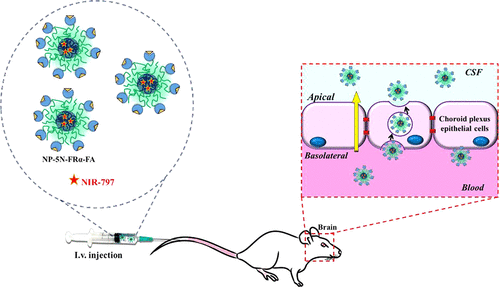当前位置:
X-MOL 学术
›
ACS Appl. Mater. Interfaces
›
论文详情
Our official English website, www.x-mol.net, welcomes your
feedback! (Note: you will need to create a separate account there.)
Folate Receptor α-Modified Nanoparticles for Targeting of the Central Nervous System
ACS Applied Materials & Interfaces ( IF 8.3 ) Pub Date : 2019-10-22 , DOI: 10.1021/acsami.9b14659 Nataliya Kuplennik 1 , Kristina Lang 2 , Robert Steinfeld 2 , Alejandro Sosnik 1
ACS Applied Materials & Interfaces ( IF 8.3 ) Pub Date : 2019-10-22 , DOI: 10.1021/acsami.9b14659 Nataliya Kuplennik 1 , Kristina Lang 2 , Robert Steinfeld 2 , Alejandro Sosnik 1
Affiliation

|
Effective and timely delivery of therapeutic agents from the systemic circulation to the central nervous system (CNS) is often precluded by the blood–brain barrier (BBB) and the blood–cerebrospinal fluid barrier (BCSFB). A new pathway of folate uptake mediated by folate receptor alpha (FRα, molecular weight of 28.29 kg mol–1) occurring in various epithelial cells of the CNS (e.g., choroid plexus) was described. Aiming to investigate this mechanism for the delivery of nanomedicines to the CNS, in this work, we initially produced nanoparticles (NPs) made of a highly hydrophobic poly(ethylene glycol)-b-poly(ε-caprolactone) (PEG-b-PCL) block copolymer functionalized with an amine moiety in the edge of the PEG block by a simple nanoprecipitation method. Hydrophilic PEG blocks migrated to the NP surface during formation, exposing primary amine groups that were used to conjugate the targeting ligand, FRα. The size of the NPs was in the 58–98 nm range and standard deviation (S.D., a measure of the size population peak width) of 26–41 nm, as measured by dynamic light scattering (DLS). The FRα conjugation yield ranged between 50% and 75% (determined indirectly by the bicinchoninic acid protein assay). Pristine and FRα-modified NPs showed good compatibility with primary human choroid plexus epithelial cells (HCPEpiCs). The uptake of FRα-conjugated NPs by HCPEpiCs was qualitatively evaluated in vitro using inverted optical fluorescence and confocal microscopy. FRα-modified NPs were internalized by HCPEpiCs to a greater extent than the unmodified counterparts. Then, their permeability was characterized in standard and inverted HCPEpiC monolayers. In both cases, NPs surface modified with the FRα and complexed to folic acid (FA) showed significantly higher apparent permeability coefficient (Papp) values than the pristine ones. Finally, the biodistribution of unmodified and FRα-FA-modified NPs following intravenous (i.v.) administration was compared in ICR mice. Results indicated that conjugation of the FRα-FA complex to the NP surface promotes higher accumulation in the brain, highlighting the promise of FRα-FA-modified NPs to serve as a platform for the targeting of active molecules to the CNS from the systemic circulation.
中文翻译:

叶酸受体α修饰的纳米粒子靶向中枢神经系统。
血脑屏障(BBB)和血脑脊液屏障(BCSFB)通常无法有效地将治疗剂从全身循环有效地输送到中枢神经系统(CNS)。描述了由中枢神经系统的各种上皮细胞(例如脉络丛)中的叶酸受体α(FRα,分子量为28.29 kg mol –1)介导的叶酸吸收的新途径。为了研究这种将纳米药物输送到中枢神经系统的机制,在这项工作中,我们最初生产了由高度疏水的聚乙二醇-b-聚己内酯(PEG- b)制成的纳米颗粒(NPs)。-PCL)嵌段共聚物通过简单的纳米沉淀方法在PEG嵌段的边缘被胺部分官能化。亲水性PEG嵌段在形成过程中迁移到NP表面,暴露出用于结合靶向配体FRα的伯胺基。NP的大小在58–98 nm范围内,通过动态光散射(DLS)测得的标准差(SD,对大小种群峰宽的度量)在26–41 nm之间。FRα的结合产率在50%到75%之间(通过双辛可宁酸蛋白质测定法间接确定)。原始的和FRα修饰的NP与原代人脉络丛上皮细胞(HCPEpiC)表现出良好的相容性。使用倒置荧光和共聚焦显微镜在体外定性评估了HCPEpiC对FRα结合的NP的吸收。HCPEpiC将FRα修饰的NP内化的程度比未修饰的对应物更大。然后,在标准HCPEpiC和倒置HCPEpiC单层中对它们的渗透性进行了表征。在这两种情况下,经FRα表面修饰并与叶酸(FA)络合的NP均具有明显更高的表观渗透系数(P app)值比原始值高。最后,在ICR小鼠中比较了静脉内(iv)给药后未修饰的和FRα-FA修饰的NP的生物分布。结果表明,FRα-FA复合物与NP表面的结合促进了大脑中更高的蓄积,突显了FRα-FA修饰的NP有望作为将活性分子从全身循环靶向中枢神经系统的平台。
更新日期:2019-10-23
中文翻译:

叶酸受体α修饰的纳米粒子靶向中枢神经系统。
血脑屏障(BBB)和血脑脊液屏障(BCSFB)通常无法有效地将治疗剂从全身循环有效地输送到中枢神经系统(CNS)。描述了由中枢神经系统的各种上皮细胞(例如脉络丛)中的叶酸受体α(FRα,分子量为28.29 kg mol –1)介导的叶酸吸收的新途径。为了研究这种将纳米药物输送到中枢神经系统的机制,在这项工作中,我们最初生产了由高度疏水的聚乙二醇-b-聚己内酯(PEG- b)制成的纳米颗粒(NPs)。-PCL)嵌段共聚物通过简单的纳米沉淀方法在PEG嵌段的边缘被胺部分官能化。亲水性PEG嵌段在形成过程中迁移到NP表面,暴露出用于结合靶向配体FRα的伯胺基。NP的大小在58–98 nm范围内,通过动态光散射(DLS)测得的标准差(SD,对大小种群峰宽的度量)在26–41 nm之间。FRα的结合产率在50%到75%之间(通过双辛可宁酸蛋白质测定法间接确定)。原始的和FRα修饰的NP与原代人脉络丛上皮细胞(HCPEpiC)表现出良好的相容性。使用倒置荧光和共聚焦显微镜在体外定性评估了HCPEpiC对FRα结合的NP的吸收。HCPEpiC将FRα修饰的NP内化的程度比未修饰的对应物更大。然后,在标准HCPEpiC和倒置HCPEpiC单层中对它们的渗透性进行了表征。在这两种情况下,经FRα表面修饰并与叶酸(FA)络合的NP均具有明显更高的表观渗透系数(P app)值比原始值高。最后,在ICR小鼠中比较了静脉内(iv)给药后未修饰的和FRα-FA修饰的NP的生物分布。结果表明,FRα-FA复合物与NP表面的结合促进了大脑中更高的蓄积,突显了FRα-FA修饰的NP有望作为将活性分子从全身循环靶向中枢神经系统的平台。





















































 京公网安备 11010802027423号
京公网安备 11010802027423号